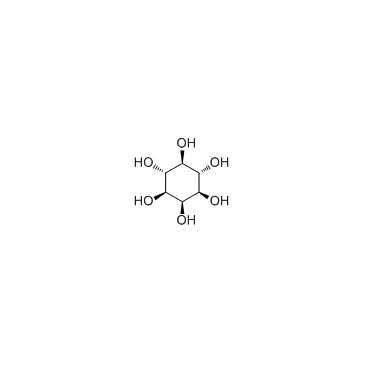Inositol

Inositol structure
|
Common Name | Inositol | ||
|---|---|---|---|---|
| CAS Number | 87-89-8 | Molecular Weight | 180.156 | |
| Density | 2.0±0.1 g/cm3 | Boiling Point | 291.3±40.0 °C at 760 mmHg | |
| Molecular Formula | C6H12O6 | Melting Point | 220-228ºC | |
| MSDS | USA | Flash Point | 143.4±21.9 °C | |
|
Urinary metabolic fingerprinting of mice with diet-induced metabolic derangements by parallel dual secondary column-dual detection two-dimensional comprehensive gas chromatography.
J. Chromatogr. A. 1361 , 265-76, (2014) This study investigates the potential of a parallel dual secondary column-dual detection two-dimensional comprehensive GC platform (GC×2GC-MS/FID) for metabolic profiling and fingerprinting of mouse urine. Samples were obtained from a murine model that mimics... |
|
|
Rapid detection of sugar alcohol precursors and corresponding nitrate ester explosives using direct analysis in real time mass spectrometry.
Analyst 140(8) , 2785-96, (2015) This work highlights the rapid detection of nitrate ester explosives and their sugar alcohol precursors by direct analysis in real time mass spectrometry (DART-MS) using an off-axis geometry. Demonstration of the effect of various parameters, such as ion pola... |
|
|
Molecular markers in ambient aerosol in the Mahanadi Riverside Basin of eastern central India during winter.
Environ. Sci. Pollut. Res. Int. 22(2) , 1220-31, (2015) Organic molecular markers are important atmospheric constituents. Their formation and sources are important aspects of the study of urban and rural air quality. We collected PM10 aerosol samples from the Mahanadi Riverside Basin (MRB), a rural part of eastern... |
|
|
Protein enrichment of an Opuntia ficus-indica cladode hydrolysate by cultivation of Candida utilis and Kluyveromyces marxianus.
J. Sci. Food Agric. 95(5) , 1094-102, (2015) The cladodes of Opuntia ficus-indica (prickly pear cactus) have a low protein content; for use as a balanced feed, supplementation with other protein sources is therefore desirable. We investigated protein enrichment by cultivation of the yeasts Candida utili... |
|
|
MiR-16 targets Bcl-2 in paclitaxel-resistant lung cancer cells and overexpression of miR-16 along with miR-17 causes unprecedented sensitivity by simultaneously modulating autophagy and apoptosis.
Cell. Signal. 27(2) , 189-203, (2014) Non-small cell lung cancer is one of the most aggressive cancers as per as the mortality and occurrence is concerned. Paclitaxel based chemotherapeutic regimes are now used as an important option for the treatment of lung cancer. However, resistance of lung c... |
|
|
NFATc1 activity regulates the expression of myocilin induced by dexamethasone.
Exp. Eye Res. 130 , 9-16, (2015) Mutations in the myocilin gene (MYOC) account for 10% of juvenile open-angle glaucoma cases and 3-4% of adult onset primary open-angle glaucoma cases. It is a secreted glycoprotein found in many ocular and non-ocular tissues and has been linked to elevated in... |
|
|
Expression of bifidobacterial phytases in Lactobacillus casei and their application in a food model of whole-grain sourdough bread.
Int. J. Food Microbiol. 216 , 18-24, (2015) Phytases are enzymes capable of sequentially dephosphorylating phytic acid to products of lower chelating capacity and higher solubility, abolishing its inhibitory effect on intestinal mineral absorption. Genetic constructions were made for expressing two phy... |
|
|
Cheminformatics analysis of assertions mined from literature that describe drug-induced liver injury in different species.
Chem. Res. Toxicol. 23 , 171-83, (2010) Drug-induced liver injury is one of the main causes of drug attrition. The ability to predict the liver effects of drug candidates from their chemical structures is critical to help guide experimental drug discovery projects toward safer medicines. In this st... |
|
|
Translating clinical findings into knowledge in drug safety evaluation--drug induced liver injury prediction system (DILIps).
J. Sci. Ind. Res. 65(10) , 808, (2006) Drug-induced liver injury (DILI) is a significant concern in drug development due to the poor concordance between preclinical and clinical findings of liver toxicity. We hypothesized that the DILI types (hepatotoxic side effects) seen in the clinic can be tra... |
|
|
Use of Commercial Dry Yeast Products Rich in Mannoproteins for White and Rosé Sparkling Wine Elaboration.
J. Agric. Food Chem. 63 , 5670-81, (2015) In sparkling wines, mannoproteins released during yeast autolysis largely affect their final quality. This process is very slow and may take several months. The aim of this work was to study the effect of several commercial dry yeast autolysates on the chemic... |